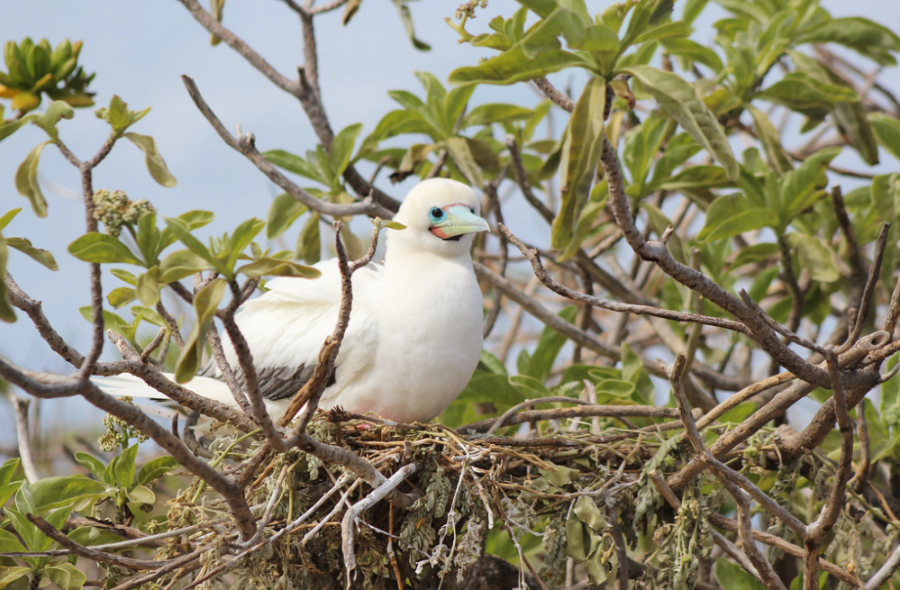Bird Poop: The Stinky, Gross, and Unlikely Heroes of Coral Reefs
The Red-footed booby, a seabird that inhabits the Chagos Archipelago
Nobody likes bird poop. It’s stinky, gross, and your first reaction towards it is probably something along the lines of “ew”. To the coral reefs of the Chagos Archipelago in the Indian Ocean, however, bird poop—and the seabirds such as terns and noddies who release it—is their hero.
How does this work? How is bird poop, the nasty substance that many of us detest, beneficial for the environment? The answer lies in a certain chemical found in it: nitrogen. Bird poop, also known as guano, is rich in nitrogen thanks to the bird’s diet. Nitrogen is a chemical element that has fertilizer properties, which means that it contributes to the growth of ocean plants and algae. With reefs around the world endangered due to climate change, researchers are looking for ways to save them—and the nitrogen in guano is one solution that works.
According to biochemist David Gillikin, 15 to 50 percent of nitrogen found in coral reefs comes straight from seabird droppings. When the nitrogen-rich seabird guano washes into the ocean and acts as a fertilizer for the ocean plants and algae, the number of ocean plants and algae naturally increases. As a result, the number of fish that live nearby increases as well. These fish help clean up dead coral and algae stuck on the reefs, which is essential to maintaining healthier coral reefs as it creates space for baby corals to grow.
But, just like any other story, every great hero needs its villain—for the seabirds, their villain is the black rat. Introduced to the Chagos Archipelago by humans in the late 18th and early 19th centuries, these invasive creatures wreak havoc on the local ecosystem by preying on seabird eggs, chicks, and even adults.
A study conducted by researchers such as ecologist Nick Graham at Lancaster University shows that islands populated by rats had approximately only two seabirds per hectare, and subsequently less healthier reefs. As Holly Jones, a restoration ecologist from Northern Illinois University, puts it: “The depth of this research shows just how much ecosystems impacted by invasive rats have to lose.”
Efforts are being made to eradicate black rats from the entire Chagos Archipelago. Currently, out of the 40 islands in the Chagos Archipelago, only three are successfully rat-free. But, researchers aren’t discouraged.
Nick Graham, whose team conducted a study on the correlation between seabirds and rats in the archipelago, says that managing reefs by getting rid of rats is “low-hanging fruit”, and that the money needed is “not a huge amount”.
As rats and climate change threaten the coral reefs and the heroic seabirds that protect these reefs, it’s clear that the seabirds need help—a sidekick, as one might say. Perhaps it’s now time for us humans to overcome our disgust towards bird poop and take on the role of the poop protector.
—
Sources:
Blaszczak-Boxe, Agata. “Facts About Nitrogen.” LiveScience, 28 September, 2017. (https://www.livescience.com/28726-nitrogen.html)
Graham, Nick. et al. “Seabirds enhance coral reef productivity and functioning in the absence of invasive rats.” Nature. Vol. 559, 12 July. 2018, p. 250.
Rosenbaum, Leah. “Bird poop helps keep coral reefs healthy, but rats are messing that up.” Science News, 11 July. 2018. (https://www.sciencenews.org/article/bird-poop-helps-keep-coral-reefs-healthy-rats-are-messing)
Savage, Candida. “Seabird nutrients are assimilated by corals and enhance coral growth rates.” Scientific Reports 9. 12 March. 2019.
Yong, Ed. “How Rats Remake Coral Reefs.” The Atlantic, 12 July. 2018. (https://www.theatlantic.com/science/archive/2018/07/how-rats-remake-coral-reefs/564899/)

